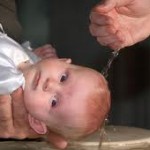For the first 1500 years of the church’s existence, the answer would have been a unanimous “yes” to this question. However, since the Reformation, especially in the contemporary evangelical church, baptism is viewed primarily of a symbol, rather than a sacramental act of God.
There are, broadly speaking, two different views of what the Sacraments are. For many in the evangelical church, grace comes apart from the Sacraments to the individual, and the individual who recieved grace then demonstrates his faith through the acts of Baptism, and recieving Holy Communion. For the other view, the sacramental position, Baptism and the Lord’s Supper are means by which grace comes to the individual. They are not works of man to demonstrate his faith, but works of God which bring forgiveness of sins, and grant and strengthen faith. And so the question is: which view does Scripture teach? Is Baptism a symbol of one’s profession of faith? Or is it a means that God uses to save?
Let’s take a look, briefly, at some of the texts in the New Testament that speak of Baptism. First, observe 1 Peter 3:20-22, which directly uses the phrase “Baptism now saves you”:
“when God’s patience waited in the days of Noah, while the ark was being prepared, in which a few, that is, eight persons, were brought safely through water. Baptism, which corresponds to this, now saves you, not as a removal of dirt from the body but as an appeal to God for a good conscience, through the resurrection of Jesus Christ, who has gone into heaven and is at the right hand of God, with angels, authorities, and powers having been subjected to him.”
In this text, Peter makes a parallel between what happened during the days of the flood, and what happens to the Christian through Baptism. Noah and his family were saved through water; you, as Christians, are now also saved through water. It’s clear that the parallel he makes uses the reality of water in both instances, so thus it is clear that this is not talking about some “Spirit baptism” which is separate from water. According to Peter, Baptism is an appeal to God for a good conscience. This means that one’s conscience is cleansed through the waters of Baptism, as sins are forgiven. If Peter believed that Baptism was a symbol of one’s faith, would he have used this language? Would his parallel between the flood and Baptism make any sense? I don’t think so.
Paul speaks about Baptism an aweful lot in his epistles. Let’s look at a few of those instances.
“Do you not know that all of us who have been baptized into Christ Jesus were baptized into his death? We were buried therefore with him by baptism into death, in order that, just as Christ was raised from the dead by the glory of the Father, we too might walk in newness of life.” (Romans 6:3-4)
According to Paul, Baptism unites us to Christ’s death, and gives us the ability to walk in newness of life. There is no language of Baptism as a symbol or an act of obedience here.
“For as many of you as were baptized into Christ have put on Christ.” (Galatians 3:27)
When one is baptized, they are baptized into Christ, and a special relationship between Christ and the believer is born wherein one “puts on Christ.” Again, no talk of symbolism.
“In him also you were circumcised with a circumcision made without hands, by putting off the body of the flesh, by the circumcision of Christ, having been buried with him in baptism, in which you were also raised with him through faith in the powerful working of God, who raised him from the dead. And you, who were dead in your trespasses and the uncircumcision of your flesh, God made alive together with him, having forgiven us all our trespasses, by canceling the record of debt that stood against us with its legal demands. This he set aside, nailing it to the cross. He disarmed the rulers and authorities and put them to open shame, by triumphing over them in him.” (Colossians 2:11-15)
Like in Romans 6, Paul speaks of Baptism as an act of death and resurrection. We are buried with Christ in Baptism, and are then raised with him. Note that Paul speaks of both salvation through Baptism, and salvation through faith. These two ideas are not mutually exclusive, but rather, Baptism is a means by which faith is given, and is the giving of God’s Gospel promise which faith clings to. This act of Baptism, which is a spiritual circumcision according to the Paul, causes us to be made alive with Christ and forgiven through Christ’s death.
There are many other passages in Paul we could look at (Tit. 3:4-7, Eph. 4:4-6, 1 Cor. 6:11), but for the sake of brevity, let’s take a quick look at the book of Acts. The clearest testimony to the effect of Baptism comes from Peter’s sermon in chapter 2:
“‘Let all the house of Israel therefore know for certain that God has made him both Lord and Christ, this Jesus whom you crucified.’ Now when they heard this they were cut to the heart, and said to Peter and the rest of the apostles, ‘Brothers, what shall we do?’ And Peter said to them, ‘Repent and be baptized every one of you in the name of Jesus Christ for the forgiveness of your sins, and you will receive the gift of the Holy Spirit. For the promise is for you and for your children and for all who are far off, everyonewhom the Lord our God calls to himself.’” (Acts 2:36-39)
Here is an instance where this group of Jews become convincedof their guilt for rejecting and crucifying the messiah. After being “cut to the heart” (meaning that they felt the guilt of their sin), they ask, “brothers what shall we do?” Remember, the problem they are facing is their guilt for rejecting the messiah. The people are asking: what do we do about the guilt for the horrible crime we committed against the Son of God? And Peter gives them a very direct answer: “Repent and be baptized every one of you in the name of Jesus Christ for the forgiveness of your sins, and you will recieve the gift of the Holy Spirit.” Through Baptism, these Jews could be forgiven, and their consciences cleansed. They also would recieve the Holy Spirit. Note that the text does not say: “repent and believe, and then be Baptized to profess your faith,” or “be Baptized symbolizing the forgiveness of sins,” but “be baptized for the forgiveness of sins!”
The story of Ananias has a similar message about Baptism:
“And one Ananias, a devout man according to the law, well spoken of by all the Jews who lived there, came to me, and standing by me said to me, ‘Brother Saul, receive your sight.’ And at that very hour I received my sight and saw him. And he said, ‘The God of our fathers appointed you to know his will, to see the Righteous One and to hear a voice from his mouth; for you will be a witness for him to everyone of what you have seen and heard. And now why do you wait? Rise and be baptized and wash away your sins, calling on his name.’” (Acts 22:12-16)
Paul says that Ananias’ Baptism would wash away his sins, not symbolize the washing away of sins which would happen apart from Baptism.
These passages could be multiplied, especially as one looks at certain texts in the Gospels which there isn’t space for here. The topic of Baptism arises frequently in the New Testament (as well as the Old Testament; look at the prophecy of Ezekiel 36 for example), and every time it is mentioned it is said to actually dosomething. It is never said to be a mere symbol. It unites to Christ’s death and resurrection, brings the forgiveness of sins, grants the Holy Spirit, and ultimately, as Peter puts it: “now saves you.”











